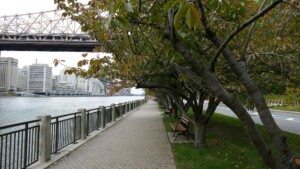The New York and Seoul–based Obra Architects, along with Front Inc., Obra Abrim, Dongsimwon Landscape, and Supermass Studio, have created an oasis of “perpetual spring” in a public courtyard in Seoul. Supported by Korea’s National Museum of Modern and Contemporary Art as part of their exhibition The Square: Art and Society, the experimental pavilion features 150 polycarbonate “eyes” that look into a lush venue full pf weather designed to be blissful year-round. This Climate Correcting Machine does away with fall and winter to comment on the ongoing climate crisis and how environmental conditions shape how we coexist with one another.
The high-concept greenhouse uses an adaptable climate control system with photovoltaic panels on the museum’s roof powering exhaust fans, aluminum curtains, and phase-change radiant floor-heating to keep the space in constant vernal equilibrium. A garden, one that normally could only survive outdoors in spring, will be growing throughout the colder months while digital displays provide info to visitors on global environmental data.
The architects suggest that the season of spring is conducive not only to happiness and socializing, but to progressive values, debate, and organizing, citing events like the 1968 Prague Spring and the 2010 Arab Spring. In that spirit, the installation is designed to be a gathering point and venue for programming such as lectures, readings, and performances, as well as discussion groups. “There can be a lot of elitism in how museums are curated, this opens it up to anyone,” explained Obra principal Pablo Castro. In addition, various guests have been invited to discuss issues related to democracy and the ongoing climate emergency.
The Climate Correcting Machine is a prototype for a larger “project with a capital P,” according to Castro. “We’re not building a particular space, but a deployable system.” Future systems, which are being developed along with Front and Arup, would have even more automated technologies, heating walls, and feature sensors both inside and at a distance that operate HVAC and lighting systems by taking into account approaching weather and “climactic inertia.”











